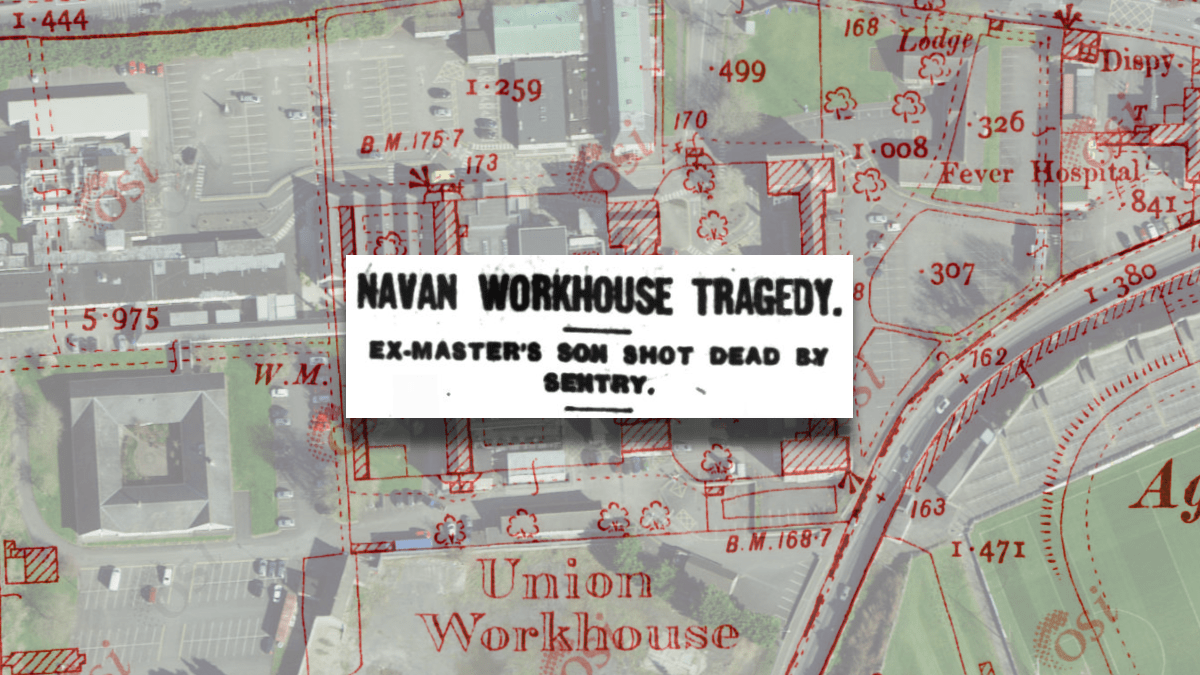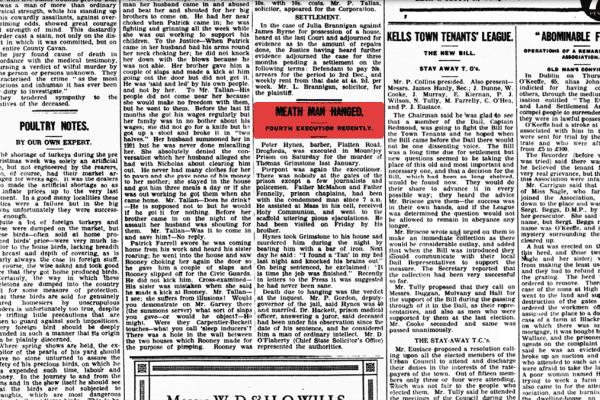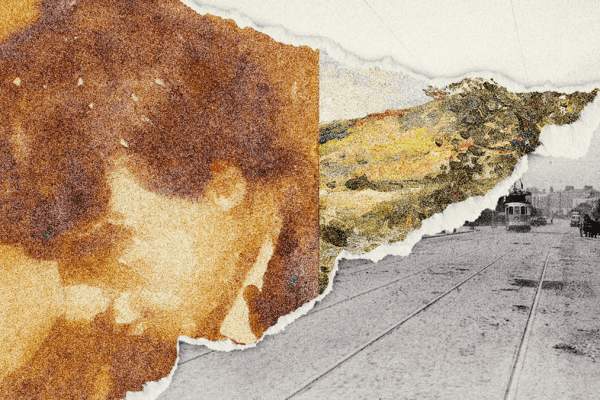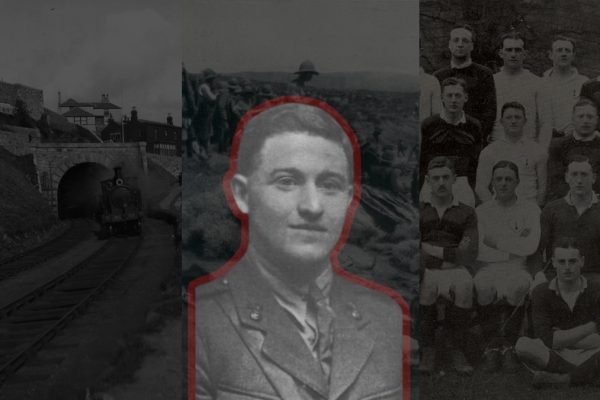As Dublin grappled with the fallout in 1920 of what would later be dubbed “Bloody Sunday”, reverberations spread beyond the capital to Navan, County Meath, claiming the life of an innocent journalist: Austin Cowley.
The 1901 Census for part of Navan Workhouse lists one John Cowley, the 70-year-old workhouse master. He had served in this position for the better part of 53 years, succeeding his father, Austin, the first master, upon his death.1 Also listed on John’s census return is his son, Austin Francis, named in honour of his grandfather. He is 49 years old, unmarried, and working as a “journalist and commission agent”.2

Austin didn’t always work as a journalist. Previously, he was a commercial traveller for Campbell’s, a tea and wine merchant situated on Sackville Street (now O’Connell Street) in Dublin City.3 This role took him across every corner of Ireland and Great Britain.4
But by the time the enumerator for the 1901 census visited Navan Workhouse, Cowley had made a career change. Now he plied his trade as a journalist, with his forte being sports. He supplied cricket, polo and hunting pieces for various newspapers throughout Ireland and Great Britain,5 with his writing of hunting chases labelled as “masterpieces”. Keen to expand his repetoire, he also branched out to musical critique, writing reviews of the new operas that came to Dublin.4 He continued his ascent in the world of journalism by joining the Irish branch of the Institute of Journalists, where, in 1904, members elected him as an Associate.6
His father died in 1911, leaving his son £129 (approx. €15,000 in 2024).7 However, Austin continued to stay in the workhouse grounds afterwards, residing in an apartment by the infirmary to the rear of the building.8
Soldiers in the Workhouse
With tensions and conflict rising in the ensuing years as Ireland sought independence, the British government imposed a de facto military rule within the country.9 This evolved into the Restoration of Order Act, which replaced civil with military power and effectively imposed martial law, labelling ordinary law as “inadequate”.10
Regiments were posted to towns and cities across the island, taking up residence in any building that could house them. One ideal location was workhouses. They were designed to hold hundreds of people, made of stone with high walls that allowed for easy fortification, and many were strategically located, allowing personnel an extensive view of their surroundings.11

With these factors in mind, unsurprisingly, in June 1920, lorries full of soldiers from the 1st Battalion Cameronians trundled into Navan.12 They requisitioned a large section of the workhouse for themselves, forcing the old men who normally slept in dorms downstairs to sleep upstairs.13 The soldiers soon made themselves at home, driving stakes into the grounds to set up barbed wire entanglements, much to the dismay of locals.14
Less than three weeks after their arrival, the Cameronians were replaced. In their place, two companies from the South Wales Borderers moved into the workhouse, arriving via Gormanston Camp on 2 July 1920.11 Their conduct still didn’t ingratiate themselves to the people at the workhouse and in Navan overall. A lorry rounding a corner too quickly damaged a laurel bush on the premises, soldiers trampled on the potatoes grown on the grounds, broke down fences, and fired shots at night.15,16
By the end of July, it appeared that the soldiers weren’t leaving anytime soon as materials for winter began arriving.17 They barricaded the workhouse with sandbags to the extent that one reporter remarked that “a fly could not get through”.18
The sentries challenged people going into the workhouse on business and, at a meeting of the workhouse board, the possibility of hiring a watchman to prevent trespassing was quashed for fear he might be shot.16 The ambulance driver also refused to go to the workhouse after 8 p.m. as he deemed it to be too dangerous.19
Sunday, Bloody Sunday
On 21 November 1920, the event that would go down in history as “Bloody Sunday” occurred in Dublin, with Irish Republican Army personnel assassinating people they suspected to be British intelligence agents. British forces retaliated by indiscriminately firing upon players and spectators as they watched a Gaelic football match in Croke Park – ultimately killing 14 people.
Word began to filter through to the various military camps about reported disturbances in Dublin. As pious as ever, that evening, Cowley went down the road from the workhouse to St. Mary’s Roman Catholic Church in Navan. There, he prayed the Stations of the Cross, going from station to station.4 Though, amid this devotion, his health was declining and his hearing over the years had degraded to the point where he was close to deaf.20
Once finished, he went towards the workhouse after 6 p.m. to return to his apartment. Austin usually cut through part of the yard in the military-occupied section of the grounds.4 This was never an issue, as he was on good terms with the soldiers around the workhouse and well-liked by them.21 As the days got shorter, the darkness was rapidly closing in, and the moon was beginning its ascent as he followed his usual route that he had performed many times before.
One of the sentries dotted around the workhouse grounds that evening was Private John Stride. His post gave him a view of the infirmary yard and a nearby gateway. Before coming on duty, his superior issued him his instructions and told him to be on alert due to the events in the capital earlier that day. He was to order everyone who went by after dark to stop. If the individual ignored the order, then he was to try again. If the person continued and he felt that they were suspicious or that his life was in danger, then he was to fire.20
Not long after coming onto his post, Stride saw a figure going through the gate in the darkness, cloaked by the shadow of the high wall. It was Cowley. He inspected the silhouette and didn’t see a cap, confirming to him that it wasn’t a fellow soldier. With tension heightened and following the orders his superior gave him not long ago, Stride yelled, “Halt, who goes there?” Cowley kept walking. Stride called again for the person to identify themselves. No response. Though he was to only call out twice, he decided to chance it a third time. He yelled for him to stop.
Stride at this point was feeling vulnerable; the moon was shining right onto his back, helping illuminate him in the darkness to any nefarious individual. He positioned his rifle and aimed as low as possible, taking the sandbags impeding him into account.5 As he pulled the trigger, Cowley began to turn to face him, as if finally hearing his commands. Though, at this point, it was too late. Stride fired. The bullet pierced Cowley through the front of his abdomen, whizzed through his body, rupturing his abdominal aorta, and emerged from his lower back. Cowley fell to the ground and groaned.20
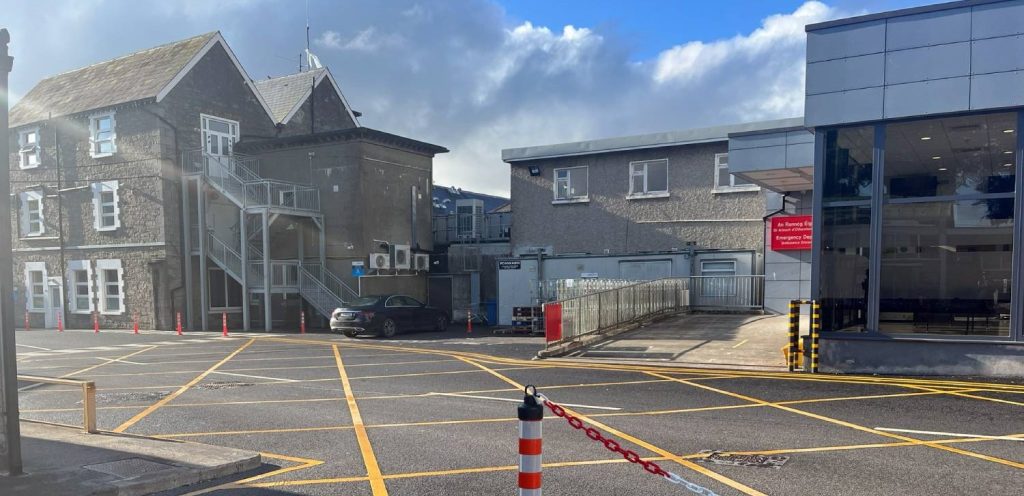
Having heard the confrontation, Stride’s superior, Lance Corporal Reginald Francis, dashed out of the makeshift guardroom towards the scene. He asked Stride, who remained at his post, what happened and went to Cowley. His eyes were closed and his mouth was open. The company sergeant major then arrived and approached Stride, telling him to stand down from his post. The sergeant major later described the private as being calm, showing “no symptoms of having lost his head.” He went over to Cowley’s body and saw that he was still barely alive, before calling for two soldiers to carry him into the guardroom.
An officer called for a priest and a doctor. The priest, Rev. John Kilmartin arrived first on the scene. He administered the last rites to Cowley. The doctor, Lawrence Finnegan, soon followed.20 Though, by now, Cowley had succumbed to his bullet wound.
The Inquest
Austin’s body remained in the workhouse overnight, and the next evening a military court convened to establish the facts around his death. Presided over by a colonel and two lieutenants, they heard accounts from the workhouse master, Private Stride, the lieutenant corporal, the sergeant major and the doctor. The court concluded that Cowley was killed by a gunshot wound in the execution of Stride’s duty and that, due to his poor hearing, he “unwittingly was the cause of his own death.” The workhouse master, Patrick Collins, acknowledged this finding, stating that none of the soldiers were responsible and the event was a tragic accident.20
After the inquest that evening, Cowley’s body was removed to St. Mary’s Church, the very building he came from the day prior.5 Worried that the death of Cowley would lead to anti-British fervour amongst the townsfolk, the workhouse master published an order on behalf of the military. It stated that demonstrations and processions for Cowley were forbidden, citing the previously mentioned Restoration of Order Act.22

(from The Drogheda Independent, 27-11-1920, p.2)
The next day, Austin’s funeral was held in a cemetery just outside Navan town, reported as being largely attended.5 Five months after his death, his friends in the hunting fraternity and around County Meath paid for a headstone placed on his grave.23
Remembering Austin Cowley
One year after Cowley’s death, in November 1921, the Board of Guardians for Navan Workhouse convened. After going over the basics, such as the minutes of last week’s meeting, the Chairman spoke about the death of Tadhg Barry.24 British forces had interned Barry, a journalist and alderman from Cork, in a military camp. A couple of days prior, while he stood on a bucket waving goodbye to fellow inmates released on parole, a young sentry shot him, and he fell dead.25 The Board voted to adjourn the meeting as a mark of respect for him. But before they broke up, Workhouse Master Patrick Collins reminded the group that in two days’ time it would be the first anniversary of Austin Cowley’s death, a journalist who also met his end with a sentry’s bullet.
References
- Poor Law Union: Navan Union. The Newry Examiner and Louth Advertiser. February 2, 1848.
- “1901 Census of Ireland”, County: Meath, DED: Navan Rural, Towland/Street: Townparks (Pt. of Rural), House 14.1. https://www.census.nationalarchives.ie/reels/nai001124504/
- Law Intelligence: An Ingenious Swindler. The Daily Express. October 30, 1882, 2.
- Meath Journalist’s Sad End. Meath Chronicle. November 27, 1920, 1.
- Navan Workhouse Tragedy. The Drogheda Independent. November 27, 1920, 3.
- Institute of Journalists: Dublin and Irish Association District. Evening Telegraph. October 12, 1904, 5.
- Probate of the Will of John Cowley.” September 6, 1911. Ireland Calendars Of Wills & Administrations 1858-1965. Image 112.
https://www.willcalendars.nationalarchives.ie/search/cwa/details.jsp?id=1639341831. - Challenge Not Heard. Irish Independent. November 22, 1920, 4.
- Bowden T. Bloody Sunday—a Reappraisal. European Studies Review. 1972;2(1):25-42. doi:10.1177/026569147200200102
- RESTORATION OF ORDER IN IRELAND BILL. (Hansard, 9 August 1920). https://api.parliament.uk/historic-hansard/lords/1920/aug/09/restoration-of-order-in-ireland-bill
- Courtney U. Tin Hats: The South Wales Borderers in Meath 1920 -1922. Ultan Courtney; 2018.
- The Latest Conquest. Meath Chronicle. June 12, 1920, 4.
- Military Occupation of Navan Workhouse. Meath Chronicle. June 19, 1920, 1.
- Casual Comments. Meath Chronicle. June 19, 1920, 3.
- Local Happenings. The Drogheda Independent. July 24, 1920, 2.
- Navan Guardians. The Drogheda Independent. July 24, 1920, 3.
- Local Snapshots. Meath Chronicle. July 31, 1920, 5.
- Local Snapshots. Meath Chronicle. July 3, 1920, 5.
- Navan Gds. and Council. The Drogheda Independent. November 13, 1920, 4.
- Courts of Inquiry in Lieu of Inquest: Austin Francis Cowley. December 4, 1920.
- Death of Mr. Cowley. Freeman’s Journal. November 23, 1920, 2.
- Demonstrations Banned By Military. The Drogheda Independent. November 27, 1920, 2.
- Local Snapshots. Meath Chronicle. April 9, 1921, 5.
- Navan Board of Guardians and Council. The Drogheda Argus. November 26, 1921, 5.
- Ó Drisceoil D. Utter Disloyalist: Tadhg Barry and the Irish Revolution. Mercier Press; 2021.
